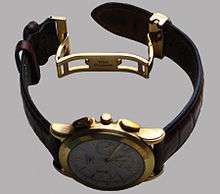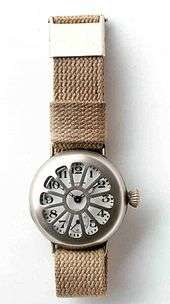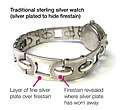Watch strap
A watch strap, watch band, or watch bracelet is a bracelet that straps a wrist watch onto the wrist.[1] Watch straps may be made of leather, plastic, rubber, cloth, or metal, sometimes in combination. It can be regarded as a fashion item, serving both a utilitarian and decorative function. Some metal watch straps may be plated with, or even in rare cases made of, precious metals.

Watch straps may close with a buckle or a folding clasp. Expanding watch straps are designed to expand elastically, often by the use of metal springs in a segmented design, and may be slipped on like a bracelet. Attachment points for the strap to the watch are largely standardized, with a spring bar (a spring-loaded double-ended pin) used to anchor the watch strap to holes in a bracket that is integral to the watch case, allowing worn watch straps to be replaced or swapped with new straps for fashion purposes.
Both metal watch cases and watch straps incorporating metal parts can sometimes cause contact dermatitis in susceptible individuals.[2] Special anti-allergy watch straps, like a NATO style watch strap, which shield the skin from exposure to metal parts, are available for sufferers of this type of dermatitis.
Specialist expanding watch straps exist for use with diving watches. With increasing depth and rising water pressure the (sleeved) wrist of a diver is exposed to compression effects that have a shrinking effect on the wrist circumference. Many watch straps intended for diving watches have rippled or vented sections near the attachment points on the watch case to facilitate the required flexibility to strap the watch exaggeratedly tight for normal wear at the surface whilst keeping the watch adequately tight in place on the diver's wrist at depth.
NATO Straps
NATO watch straps, or as known as "NATO Straps" were developed by the British Ministry of Defense for wartime usage (DefStan 66-47[3]). The colour of the nylon ribbon (20 mm wide) shall be to BS 4800 card number 3, reference 18B25, colour grey. It is a one piece strap slid through the spring bar of the watch case and then slid into the appropriate notch, and then folded back to secure excess strap and prevented from sticking out of the main watch strap portion. The nylon composition of the strap prevents metal from touching the skin of the wearer and provides stability while wearing it. The durability of the strap prevents moisture from wicking away on the skin, as well as remaining on the wrist of the wearer even if the spring bar of the wrist were to pop out.[4]
Popular usage of the NATO strap includes being used in James Bond Movies, in order to accessorize and provide strength to the watches worn by the United Kingdom based 007 Agent in the field. Following the popularity of the NATO Strap being used in James Bond movies, the NATO strap became a staple of watches produced by Omega, including releasing limited edition versions of the strap in their watch collections.[5]
NATO straps are known for being relatively inexpensive. Most straps are made of nylon and stainless steel fasteners that guide the strap through the formation of the watch. NATO straps are also known for being easy to clean and swap around for daily use.[6] NATO straps are available in different sizes, lengths and designs to accommodate a wide variety of designs and watch composures. NATO straps are also used amongst deep sea divers and water-sports.
 A buckle fastening for a leather watch strap.
A buckle fastening for a leather watch strap. A cloth watch strap dating to World War I.
A cloth watch strap dating to World War I.
- A watch with a segmented stainless steel watch bracelet.
 A silver-plated metal watch bracelet, showing signs of wear.
A silver-plated metal watch bracelet, showing signs of wear. A watch with a gold-plated ROWI Fixoflex expandable/retractable elastic watch bracelet.
A watch with a gold-plated ROWI Fixoflex expandable/retractable elastic watch bracelet. A watch with a stainless steel mesh bracelet.
A watch with a stainless steel mesh bracelet. A specialist expanding watch strap for diving watches.
A specialist expanding watch strap for diving watches.- Stainless steel bracelet with deployant clasp and diver's extension.
See also
- Smart band
- Lanyard
- Wrist clasp
References
- http://dictionary.cambridge.org/us/dictionary/british/watchstrap
- http://www.mayoclinic.org/diseases-conditions/contact-dermatitis/basics/symptoms/con-20032048
- Defence Standard 66-47, Issue 2, "Strap, Wrist Watch
- "Your Watch Needs a NATO Strap". Fortune. Retrieved 2019-11-17.
- "OMEGA and James Bond : a beautiful friendship | OMEGA US®". Omega. Retrieved 2019-11-17.
- "Learn About NATO Straps | Crown & Buckle". www.crownandbuckle.com. Retrieved 2019-11-17.